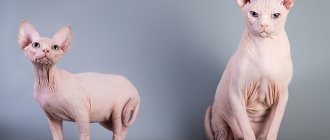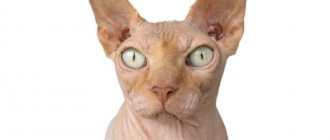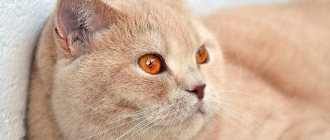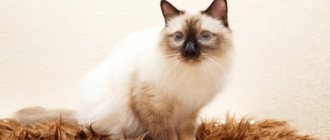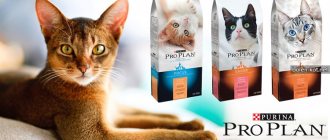Sphynxes are one of those cats that leave no one indifferent. They cause wild delight among fans of the breed and a desire to have such a hairless beauty at home. Others associate “hairless” cats with either a rat (the tail is to blame) or with aliens. Their emotions can be described as “ugh, what an abomination, such a cat will never be in my house.”
Sphynx cat with her offspring
Interestingly, Sphynx-haters can change their opinion 180 degrees by talking to these cats in person. Naked, hot, loving – it’s all about them, about sphinxes, and not what you thought.
Let's be honest - hairless cats are loved (or not loved) primarily for their unusual appearance. The character of Sphynx cats is the last thing people are interested in. More often they ask questions not about the peculiarities of temperament, but about everyday issues - is it difficult to maintain, how good is the health of sphinxes, is it true that there are no allergies to them.
We will talk about all this in this article, but I urge future owners to study first of all the temperament of their favorite breed. If the pet is loved, then no amount of caring for it will seem like a burden. If, on the contrary, the characters do not match, then no amount of external beauty or unpretentiousness of the cat will please the owners.
Author of the article: Olga Shiltsova, practicing veterinarian, author of the books “Dachshund of Fate” and “Tails of Fortune”
Character of Sphynx cats: pros and cons
Sphynxes are primarily cats. Yes, without fur, but cats. Therefore, they are characterized by many typical cat habits - a love of boxes, innate curiosity, a wary attitude towards their relatives. But there are also peculiarities. Each character trait can be considered a plus or a minus, depending on what you are looking for in an ideal pet.
Affectionate
All cats from the Sphynx group are human-oriented. They are happy to seek communication with the owner and enjoy stroking. The Sphinx will willingly climb into your arms and sleep under the blanket, cuddling with its hot side.
Affectionate blanket cat
Such a cat will never become an indifferent sofa cushion (as the British are sometimes accused of). Sphinxes run to the door to greet their loved one, like dogs. These are truly affectionate and gentle cats.
Playful
Sphynxes are fairly active cats. They are not as reactive as Abyssinian cats or Cornish Rex cats, but they are no less mischievous when young. The problem is that hairless cats are not suitable for walking, and they can get bored in an apartment.
The owner will have to devote time to his Sphynx. If you don't satisfy the need for play, your pet will start entertaining itself, and you won't like it. Playful and intelligent, Sphynx cats make excellent companions for children. They can be taught to fetch a toy in their teeth and perform other simple tricks. All kinds of teaser fishing rods, balls and mice will help you, although an ordinary bow on a string will delight a bald hunter.
Little sphinx exploring his new home
Not aggressive
All the sphinxes that I have ever treated behaved more than worthy. The owners confirm that these cats are not prone to aggressive behavior. If the sphinx has an escape route, it will run away rather than attack.
Although Sphynx cats are friendly to people, they may not get along well with other cats and dogs. Much depends on whether the owners introduce the animals correctly, as well as on the size of the territory.
The Canadian Sphynx delicately accepts a treat
So, the advantages of sphinxes: they are active, curious, affectionate and patient pets. You won't get bored with them. But you definitely need to take into account the features of hairless cats that may seem unacceptable to you:
Annoying
Sphinxes do not feel the line when the desire to communicate develops into importunity. Imagine that the cat jumps onto your lap every time you sit down. He grabs it with his paws. No claws, but it gets in the way when you're trying to brush your teeth, apply makeup, or eat. Purrs and butts, demanding attention. And he gets offended when you push him off the laptop or drop him from your hands onto the floor.
Pet the cat!
Not all sphinxes behave this way. But before you adopt a naked kitten, imagine being pestered around the clock with breaks for sleep and food. If this is exactly what you want from a cat, great. If you don’t expect your pet to follow you around, take a look at more independent breeds.
Thieves
Sphinxes spend a huge amount of energy heating their bodies. Perhaps that is why they are so voracious. These cats not only eat the food in the bowl with appetite, but also demand more. The bald-skinned miracle will, without a twinge of conscience, encroach on any food left unattended. It won't be easy to stop the sphinx from climbing tables.
So, what do you have here? Pizza?
Cat, hurry up! A giant rat in the kitchen is stealing food! Oh, no, this is the cat.
Ukrainian Levkoy became interested in pancakes left on the table
Talkative
Not all sphinxes are the same. Peterbalds, which are roughly called bald orientals, are considered the most talkative. The Canadian Sphynxes meow no less, in the breeding of which Devon Rexes were actively used. Don Sphynxes are considered the most silent and not as “crazy” as Canadians.
It is worth noting that all varieties of hairless cats are characterized by high sexual activity. Cats come into heat early, and hoarse howls during this period greatly depress the owners. The cats begin to mark their territory, and the urine becomes odorous. Therefore, it is recommended that all sphinxes not participating in breeding be neutered before puberty.
You can read more about estrus in cats here (link will open in a new tab).
Any problems?
So, the sphinx may turn out to be a loud thief, prone to pouring urine on your house and making hellish noise at night. But they are so beautiful, so unearthly. By default, such a cat is forgiven a lot. Let's move on to the next logical question - how difficult is it to care for a naked pet?
Mating
If you decide that your cat needs to give birth, it’s time to think about mating a Sphynx and everything that is associated with this event. Sphynxes mature early. Don't be surprised if your cat goes into her first heat just six months after birth. The onset of estrus is easy to notice by the changed behavior of the pet. The cat may become more affectionate or, on the contrary, show unprecedented aggression.
It is worth knowing that estrus is not a reason to breed a Sphynx. After all, physically, a six-month-old animal is still a child. Technically, a cat can give birth, but the risk of getting non-viable offspring is quite high. In addition, health problems may also arise in a young mother. For these reasons, mating during the first heat is not officially permitted.
Sphynx cats mature sexually a little longer than females. The first signs of sexual heat appear in them in the eighth month of life. For cats, this is also too young an age for mating, because he, too, has not yet physically become an adult animal. You can notice signs of puberty in a cat by its behavior; the animal begins to behave more persistently and aggressively. The pet may also begin to mark its territory.
Physically, a cat can be considered ready for mating after 2-3 heats. Ideal age is 1.5-2 years. At this point, male and female Sphynx cats are fully formed.
Do not forget that before mating you need to vaccinate and deworm the animal. Moreover, this must be done in advance - at least 14 days before the intended mating.
The stages of preparing a Canadian cat for breeding include compliance with some hygienic aspects, such as cutting nails. But it’s better not to wash your pet. Cats have an excellent sense of smell and the natural scent of their partner - this is one of the factors that attract animals of different sexes to each other.
The ideal time for mating is the third day after the start of estrus. Usually the selected pair is left together for several days, because a single mating does not provide a 100% guarantee of fertilization of the cat’s eggs.
The pregnancy of the Canadian Sphynx lasts 63 days. The first symptoms of pregnancy can be seen in the third week after mating. First of all, it is a change in behavior. A little later, physical signs will begin to appear:
- swelling of the nipples;
- abdominal enlargement;
- increased appetite.
Sphynx cats are quite fertile; a female can give birth to a litter of up to 12 cubs.
In general, mating of the Canadian Sphynx is similar to the mating techniques used with cats of other breeds.
Caring for a Sphynx cat
The obvious difference between Sphynx cats and other cats is the complete or almost complete absence of hair. At first glance, this should have made them easy to care for. There is no need to comb your pet, give it malt paste, the fur does not fly all over the apartment. In fact, caring for a Sphynx is somewhat more difficult than caring for an ordinary cat.
Rub your eyes
The eyes of sphinxes lack natural protection in the form of eyelashes. Because of this, their cornea is intensively washed with tears. A tear mixed with dust oxidizes in the air and a brown jelly can be seen in the inner corner of the eye. This discharge should be removed with a damp cotton pad every day.
This is the Don Sphynx. The eyes are deprived of natural protection in the form of eyelashes
Clean ears
Naked-skinned sphinxes produce a large amount of skin lubricant. And just as actively, brown secretion is formed in the ears. In a healthy cat, dark brown discharge is not accompanied by itching or redness of the skin. They are removed using a special softening lotion and a cotton pad.
The Sphynx's ears must be kept clean.
Bathe
If the Sphynx is not bathed, brown skin discharge will remain everywhere - on the bed linen, on the white windowsill, on the furniture. In addition, the specific smell that comes from hairless cats intensifies.
You need to wash your Sphynx with a special shampoo for hairless cats. Human products are not suitable because they disrupt the pH of the skin.
Ukrainian Levkoy in the bath (he is not happy about bathing)
The frequency of bathing is determined individually. Some unspayed cats require frequent bathing - every 2 weeks. Other cats can be washed once every 1-2 months, and some even once every six months. It all depends on the desire of the owner and the health of the skin. Typically, a cat is bathed when a specific smell becomes too strong.
As for the smell, every Sphynx owner has his own opinion about what his hairless cat smells like. Odors include cheese, boiled potatoes, mushrooms, popcorn, cooked rice and even iodine. Some cats smell so sweet that their scent is reminiscent of milk and cookies. Some are neutral, that is, leather, evoking associations with a sheepskin coat. The smell intensifies when the cat warms up under a blanket or near a radiator.
Sphynx bathing
Care for claws
To prevent your pet from scratching you, the furniture, or itself, it is better to trim its claws with a special nail clipper. It is enough to do this once every 2-3 weeks. In addition, you need to ensure that brown discharge and dirt do not accumulate in the claw bed (the fold of skin around the claw).
Nails are not trimmed
And this sphinx had a manicure done. Claws grow quickly.
Protect from cold
Completely devoid of hair, sphinxes are not adapted to our climate. But in a city apartment they are quite comfortable, if you do not wrap the kitten in clothes from childhood.
The Sphinx must be provided with a warm house, a bed or a hammock on the radiator.
The Sphinx needs his own house!
In the cold season, you may also need clothing - a soft sweater is most comfortable.
Dressing up naked cats is a special pleasure
There is an opinion that sphinxes climb into people’s arms precisely in search of warmth, and not out of great love. And a naked cat will definitely want to sleep with you under the blanket!
Mur-mur of tenderness - the Canadian Sphynx cuddles up to its owner
Origin story
The name of these cats reeks of something ancient and legendary, but in fact, the Canadian Sphynx is a fairly young breed. They began breeding it in the late seventies of the last century, and not in Egypt, as the name “Sphinx” suggests, but in Canada, in Toronto. Having found hairless kittens, they began to cross them with short-haired cats. As a result, such an unusual breed appeared. In 1966, kittens were born from a domestic cat named Elizabeth in Canada. One baby from the litter was completely bald, he was named Prune. The kitten and its mother were acquired by a couple, Regard and Yaniya Bava, who saw promise in them and began to breed a new breed. Soon they were joined by the second couple Keys and Rita Tenhove.
Initially, the Canadian Sphynxes were called “moonstone cats”, somewhat later “bald Canadians” and only recently their name was determined as the Canadian Sphynx. There is little data on the work of married couples in the breeding program. The number of cats at that time was also small and they died more often than their furry counterparts. As a result, the "experimental breed" status that TICA had previously given them was withdrawn. But the enthusiasts did not give up.
In the early 70s, representatives of the new breed moved from Canada to San Francisco and two kennels in the United States joined the work on the breed. In 1978, a pair of sphinxes was purchased by a doctor from Holland, Hugo Hernendez. And the naked cats went to another continent. In 1980, two more hairless kittens were discovered in Toronto. Apparently, these were the descendants of Prune. Having grown up, they were sent to Holland to Dr. Fernandez to participate in breeding. In 1975, in Minnesota (USA), an ordinary cat gave birth to several litters and each had hairless kittens. The babies were purchased by the Stardust nursery in Oregon. In all sphinxes, the gene for hairlessness was recessive and, apparently, entailed certain pathologies in development. After unsuccessful matings of two hairless cats, the breeder began to cross them with Devon Rex.
Thus, the Canadian Sphynxes were simultaneously bred in the USA and Holland using the Devon Rex breed. In 1998, the Canadian Sphynx was officially recognized by the CFA and after 4 years it opened a championship class for them. Today there are often reports of the appearance of hairless kittens from ordinary cats. Such individuals are often used by well-known nurseries in their programs in order to expand the gene pool of the Canadian Sphynx.
Video review of Sphynx cats:
Sphinx health
The absence of fur creates a feeling of fragility and defenselessness. Fortunately, this impression is wrong. With good care, sphinxes are long-lived, with an average lifespan of 15-16 years.
It is recommended to adopt a kitten at the age of 3 months – after the second vaccination. Annual vaccinations should not be neglected, even if the pet does not leave the apartment.
Sphynxes can be real long-livers
All bare-skinned breeds are young, but information has already been accumulated about some hereditary diseases of sphinxes. It should be remembered that Canadian and Don Sphynxes are completely different breeds. And their genetic diseases are also different. You can read more about the Canadian Sphynx in a separate article.
Nutrition
The menu of representatives of hairless cats should be as balanced as possible. This means that food must contain the required amount of fats, carbohydrates, and proteins of animal origin. It is important to calculate protein intake in a ratio of six grams per kilogram of animal weight per day. The selection of a diet must be approached with full responsibility. Otherwise, due to a lack of any substances, various diseases can be provoked.
There is always a question: which food to choose - natural or artificial. The choice is always up to the owner and depends on financial capabilities and cat preferences. Often, breeders combine food composition and use both ready-made food and natural food.
The diet of the Don Sphynx includes: meat (beef, chicken or fish); fermented milk products (kefir, cottage cheese, sour cream); fresh vegetables (cabbage, carrots); eggs.
With any type of food, the cat drinks a lot. It is important that the bowl is always filled with clean drinking water.
Is it true that there are no allergies to hairless cats?
The most persistent and harmful myth is that hairless cats are hypoallergenic. People believe they are allergic to cat hair, and adopting a hairless pet seems like a good solution. Unfortunately, most often the allergy is caused by a special protein that is found in the saliva, urine and skin secretions of cats.
The Sphynx's skin contains sebum, a protective skin lubricant. This brown substance may be an allergen. If a person is allergic to cat saliva or fur, then he will be able to live in an apartment with a naked pet. All you need to do is wash your hands thoroughly after touching the cat.
Hypoallergenic? what are you saying?
How to name
Choosing a name for a kitten is a serious and responsible process.
“Complex” names indicated in pedigrees are most often used only at exhibitions, while at home the pet can be called with a simple name that is liked by all family members.
Names for boys
There are many options for nicknames for boys:
- Asmos.
- Diamond.
- Haman
- Argon.
- Black.
- Weiss.
- Walter.
- Hamilton.
- Darcy.
- Joseph
- Ilan.
- Orlan.
- Hassan.
- And etc.
Nicknames for girls
In order to name a girl, you can use your own imagination or the suggested options:
- Ayla.
- Agnes.
- Bayla.
- Blanche.
- Gurley.
- Grissi.
- Daina.
- Dessie.
- Zhulba.
- Julie.
- Zara.
- Sylt.
- Iffy.
- Laina.
- And etc.
Reviews from Sphynx owners
“Pink naked happiness has been living with me for 12 years now. Cheddar is very clean. We wipe the eyes as necessary to remove discharge. He endures it calmly and purrs like a tractor. I love him immensely. He hugs, presses his hot body, asks to be held. He stretches out his paws and says “me-me” (sounds like mom!).”
“We have two cats - a yard, long-haired and the second is a Canadian Sphynx. We love both. But a cat is on its own, it has a character, it has its own interests. And the bald one is a member of the family, a smart friend, adored by everyone. Sphinxes are amazing! I recommend"
“My Don Sphynx is velvety to the touch and does not require complicated care. I love buying him clothes, he's so funny in them. We've already collected a whole gallery of pictures. In the summer he walks on the balcony - sunbathes, it becomes darker. In a word, there is not much more care than for an ordinary cat, but there is no hair anywhere!”
“My Sphynx daughter is 2.5 years old. The kindest cat. Loves everyone - dog, children. I wash it once a month, almost no resistance. I trim my nails regularly, once every 2 weeks. I have never regretted starting one. The only thing was that it took a long time to select food, there were problems with stool and skin. Now she eats expensive holistic food, but it's worth it."
“I took an adult, completely hairless cat. If you are too lazy to wash it, ironing becomes unpleasant, your hands are covered in brown grease. And it started to smell noticeably. I take her to the bathroom - she screams like a fool and pees on me. She didn't like to wash. At the same time, I miss her immensely, it’s been two years since she passed away. Not a single cat slept under the blanket with me, except this one.”
“Katie the Don Sphynx is the most sociable cat I’ve ever had. The squeaky one is scary - she meows for any reason. Curious. He greets and sniffs guests, but will not hold them in his arms. A mannered imaginary - she acts like a peahen, falls apart picturesquely when you pay attention to her, swags her tail importantly. She’s not aggressive at all, she’s never bitten or scratched anyone in her life.”
Tendency to diseases
Don Sphynx cats are predisposed to the following genetic diseases:
- congenital entropion of the eyelids (treated surgically);
- microphthalmos - reduction in the size of the eyeball (vision deteriorates);
- syndrome of “falling asleep kittens” (due to underdevelopment of the thymus gland, babies die);
- curvature of the caudal spine, causing a number of other pathologies (problems of the skeletal system, underdevelopment of the intestines, etc.);
- nipple hyperplasia in cats (if drugs to suppress sexual desire were used);
- undershot - shortening of the lower jaw (affects quality of life);
- skin vasculitis (inflammation of the vascular walls of the skin).
Most often, Don people have skin problems caused by excessive production of sebaceous glandular secretions. These may be the following diseases:
- dermatitis;
- eczema;
- trichophytosis;
- acne.
Absolutely naked individuals are susceptible to skin diseases more often than those with fur.
